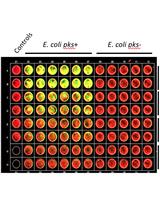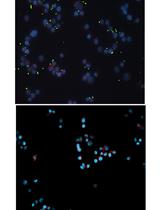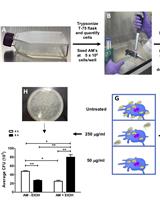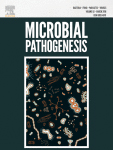- Submit a Protocol
- Receive Our Alerts
- Log in
- /
- Sign up
- My Bio Page
- Edit My Profile
- Change Password
- Log Out
- EN
- EN - English
- CN - 中文
- Protocols
- Articles and Issues
- For Authors
- About
- Become a Reviewer
- EN - English
- CN - 中文
- Home
- Protocols
- Articles and Issues
- For Authors
- About
- Become a Reviewer
Adhesion and Invasion Assay Procedure Using Caco-2 Cells for Listeria monocytogenes
Published: Vol 7, Iss 9, May 5, 2017 DOI: 10.21769/BioProtoc.2267 Views: 16272
Reviewed by: Valentine V TrotterSofiane El-Kirat-ChatelAlexander B. Westbye

Protocol Collections
Comprehensive collections of detailed, peer-reviewed protocols focusing on specific topics
Related protocols

Quantification of Colibactin-associated Genotoxicity in HeLa Cells by In Cell Western (ICW) Using γ-H2AX as a Marker
Sophie Tronnet and Eric Oswald
Mar 20, 2018 7993 Views

Adhesion of Enteroaggregative E. coli Strains to HEK293 Cells
Jorge Luis Ayala-Lujan and Fernando Ruiz-Perez
Apr 20, 2018 6800 Views

Intracellular Invasion and Killing Assay to Investigate the Effects of Binge Alcohol Toxicity in Murine Alveolar Macrophages
Victor Jimenez Jr and Fernando P Monroy
Jan 20, 2019 6657 Views
Abstract
Listeria monocytogenes is an important Gram-positive foodborne pathogen that is a particular problem in ready-to-eat food. It has an ability to survive in harsh conditions like refrigeration temperatures and high salt concentrations and is known to cross intestinal, placental and blood-brain barriers. Several cancerous cell lines like cervical, liver, dendritic, intestinal and macrophages have been used to study in vitro propagation and survival of listeria in human cells. Human intestinal epithelial cells have been used to study how listeria crosses the intestinal barrier and cause infection. The protocol in this articles describes the procedures to grow Caco-2 cells, maintain cells and use them for adhesion and invasion assays. During adhesion assay the cells are incubated with listeria for 30 min but in invasion assay the cell growth is arrested at several time points after infection to monitor the growth and survival rate of listeria in cells.
Keywords: Adhesion assayBackground
Listeria monocytogenes being a facultative intracellular bacterium can enter, survive and multiply in both phagocytic and non-phagocytic cells and this property of the bacterium has been extensively studied and understood. Being a foodborne pathogen it enters the blood stream in humans via intestines by crossing intestinal barriers. Thus human intestinal cells are used as an in vitro medium to study adhesion and intracellular survival of Listeria monocytogenes. Human colon adenocarcinoma cells, Caco-2 cells have been used extensively as a model for intestinal barrier (Angelis and Turco, 2011).The protocol described in this article explains the procedure to grow and maintain Caco-2 cells and then infect them to study adhesion and invasion properties of listerial species. This protocol can also be used with minor changes for cells like HT-29 (human colorectal adenocarcinoma cells) and Tc7 cells (a subclone of the Caco-2 cell line have) which have also been used to study Listeria. These assays are generally used to compare the pathogenicity of listerial mutants with wide type(WT) strains (Reddy and Lawrence, 2014). Adhesion assay is straight forward wherein the bacteria are incubated with Caco-2 cells for 30 min and the bacterial counts for mutants and WT strains are compared to observe any alteration in adhesion properties as a result of mutation. Bacterial counts obtained at different time points during invasion assay give more information about the survival of listeria in the human cells and the comparison of these counts between mutants and WT strains gives information about the changes in the adaptation of listeria after mutation in human cells. This protocol has been successfully used previously to study the adhesion and invasion properties of listerial strains (Jaradat and Bhunia, 2003; Lecuit, 2005; Sambuy et al., 2005; Reddy et al., 2016).
Materials and Reagents
- MF-Millipore filters (EMD Millipore, catalog number: SCGPU05RE )
- Eppendorf tubes (Eppendorf, catalog number: 022363204 )
- Cell culture flasks (Corning, catalog number: 3275 )
- Cell culture plates (12-well cell culture receiver plate, sterile) (EMD Millipore, catalog number: PIMWS1250 )
- Pipette tip
- 15 ml culture tube
- Cell scrapers (Corning, catalog number: 3010 )
- ZapCap bottle-top filters, pore size 0.2 µm (Maine Manufacturing, catalog number: 10443421 )
- Serological pipettes (1, 5, 10, 25, 50 ml) (Corning, catalog numbers: 4010 , 4050 , 4100 , 4250 , 4501 )
- Culture tubes (Sigma-Aldrich, catalog number: T1661 )
- Listeria monocytogenes strains F2365 (wild type strain), and F2365∆2117(mutant strain) (Reddy et al., 2016)
- Caco-2 cell line (ATCC, catalog number: HTB-37 )
- 70% ethanol (Fisher Scientific, catalog number: BP82014 )
- Trypsin-EDTA solution (Sigma-Aldrich, catalog number: T3924 )
- Brain Heart Infusion (BHI) agar (Sigma-Aldrich, catalog number: 70138 )
- BHI broth (Sigma-Aldrich, catalog number: 53286 )
- Gentamicin (Sigma-Aldrich, catalog number: G1397 )
- Eagle’s minimum Essential medium (EMEM) (ATCC, catalog number: 30-2003 )
- Fetal bovine serum, certified, heat inactivated (FBS) (Thermo Fisher Scientific, GibcoTM, catalog number: 10082147 )
- Penicillin-streptomycin (10,000 U/ml) (Thermo Fisher Scientific, GibcoTM, catalog number: 15140122 )
- Dulbecco’s phosphate buffered saline (Sigma-Aldrich, catalog number: D8537 )
- Triton X-100 (Sigma-Aldrich, catalog number: 234729 )
Note: This product has been discontinued. - Phosphate-buffered saline, 10x (PBS) (Sigma-Aldrich, catalog number: P5493 )
- cEMEM (see Recipes)
- 0.1% Triton-X 100 (see Recipes)
- 1x PBS (see Recipes)
Equipment
- Water bath, 37 °C (Thermo Fisher Scientific)
- CO2 forced-air incubator (Thermo Fisher Scientific, Thermo ScientificTM, model: FormaTM Steri-CultTM CO2 Incubators , catalog number: 3307TS)
- Biological safety cabinet (Thermo Fisher Scientific, Thermo ScientificTM, model: 1300 Series Class II )
- Inverted microscope(Nikon Instruments, model: Eclipse Ti-S )
- Pipette (Thermo Fisher Scientific, Thermo ScientificTM, catalog number: 4642070 )
- Pipettor (Daigger Scientific, model: Portable Pipet-Aid XP Pipette Controller )
- Hemacytometer (Fisher Scientific, catalog number: S17040 )
- 37 °C incubator (Thermo Fisher Scientific)
- 37°C shaker (Thermo Fisher Scientific)
- Microcentrifuge, 4 °C (Eppendorf)
- Fisher Scientific Sonic dismembrator (Fisher Scientific, model: 100 )
- Vortex (Thermo Fisher Scientific, Thermo ScientificTM, model: LP Vortex Mixer , catalog number: 88880018)
Procedure
- Growing and maintaining Caco-2 cell lines
- Using MF-Millipore filters prepare media, Caco-2, human colon adenocarcinoma cells are maintained in cEMEM (complete EMEM, see Recipes)
- Seeding cells:
- Thaw a vial of frozen Caco-2 cells from ATCC (or previously frozen cells in the lab) by gentle agitation in a 37 °C water bath. To reduce the possibility of contamination, keep the O-ring and cap of the tube out of the water. Thawing should be rapid (approximately 2 min)
- Remove the vial from the water bath as soon as the contents are thawed, and decontaminate by dipping in or spraying with 70% ethanol. All of the operations from this point on should be carried out under strict aseptic conditions.
- Transfer the vial contents to a centrifuge tube containing 9.0 ml cEMEM and spin at 125 x g for 5 to 7 min. Discard supernatant. Resuspend cells in 1 ml cEMEM and transfer the cell suspension to flask containing pre-warmed (37 °C) cEMEM. Place the flask in CO2 forced-air incubator at 37 °C.
- 24 h after seeding, check the cells under microscope for attachment, if attached to flask surface, slowly aspirate media to remove dead cells and add pre-warmed (37 °C) cEMEM.
- Thaw a vial of frozen Caco-2 cells from ATCC (or previously frozen cells in the lab) by gentle agitation in a 37 °C water bath. To reduce the possibility of contamination, keep the O-ring and cap of the tube out of the water. Thawing should be rapid (approximately 2 min)
- Re-feed cells every 48-72 h or when the color of the media changes. For re-feeding the cells, carefully aspirate the existing media using pipette and add fresh media to the flasks without disturbing the cells.
- Check cells for contamination and confluency every 48 h. When 80% of the flask surface is covered by cells, they are ready for passaging (Natoli et al., 2012).Cells need to be passaged for a minimum of 3 cycles before using them for the experiment. When the flask is contaminated, the media is cloudy and cells do not adhere to the flask surface.
- For passaging, remove media and wash monolayer with 1x PBS. Add 2-4 ml (depending on the size of flask) of trypsin-EDTA solution and incubate at 37 °C for 1-4 min (do not over incubate cells). When cells start sloughing add media (1:10, trypsin to media ratio) to inactivate trypsin and thoroughly pipette several times to get a uniform cell suspension.
- Count cells using a hemacytometer and seed a 12 well cell culture plate with a density of 105 cells/well. Each cell will require 1 to 2 ml depending and the size and manufacturer. Calculate the cells accordingly.
- Using MF-Millipore filters prepare media, Caco-2, human colon adenocarcinoma cells are maintained in cEMEM (complete EMEM, see Recipes)
- Preparation of bacterial culture
- Using sterile microbiology technique streak listeria strains (WT and Mutant) from frozen cultures on BHI agar and place them in a 37 °C incubator for 48 h.
- From a freshly grown bacterial culture plate pick single isolated colony with a pipette tip and drop it in a 15 ml culture tube containing 10 ml BHI broth. Incubate the tubes in a 37 °C shaker for overnight. (see Note 5)
- Overnight cultures (15 ml) of F2365 (wild type) and F2365∆2117 (mutant) L. monocytogenes strains in BHI broth are adjusted to an OD600 = 1.0 using fresh BHI broth on the day of infection if necessary.
- For each strain, pellet 100 µl of the above bacterial suspension in a bench top micro centrifuge for 2 min at 3,000 x g.
- Wash pellet and resuspend it in 1 ml of fresh warm (37 °C) cEMEM.
- Use 30 µl from step B3 for infections with Caco-2 cells.
- Using sterile microbiology technique streak listeria strains (WT and Mutant) from frozen cultures on BHI agar and place them in a 37 °C incubator for 48 h.
- Adhesion assay
- Plates with Caco-2 cells from step A5 are infected following the template shown in Figure 1 with bacterial culture from step B3 (Multiplicity of infection [MOI]: 1 Caco-2 cell:10 bacterial cells).

Figure 1. Plate template for infection of Caco-2 cells. Caco-2 cells are seeded in 12 well cell culture plates and infected with appropriate bacterial strain as labeled in the template. Infections were performed in three replicates per plate for each strain. Three wells were uninfected or untreated and three wells were infected with cEMEM sans bacteria and acted as negative controls (NC1 and NC2). - Infect one well at a time and change pipette tip after every infection. (see Note 4)
- Centrifuge the plates briefly for 45 sec and incubate them at 37 °C for 30 min. Centrifugation aids mixing and binding of bacteria to mammalian cells.
- After incubation wash cells five times with 1x PBS and lyse using 500 µl of cold 0.1% Triton X-100.
- The resulting suspensions are diluted (1/100, 1/1,000 and 1/10,000) using 1xPBS.
- 100 µl of 1/1,000 and 1/10,000 diluted suspensions are spread on BHI agar, and grown at 37 °C for 48 h. (see Note 5)
- 48 h post incubation count bacterial colonies, record and calculate colony forming units.
- Plates with Caco-2 cells from step A5 are infected following the template shown in Figure 1 with bacterial culture from step B3 (Multiplicity of infection [MOI]: 1 Caco-2 cell:10 bacterial cells).
- Invasion assay
- Plates with Caco-2 cells from step A5 are infected with bacterial culture from step B3 (MOI:1 Caco-2 cell:10 bacterial cells) as shown in Figure 1.
- Infect one well at a time and change pipette tip after every infection. (see Note 4)
- Centrifuge the plates briefly for 45 sec and incubate them at 37 °C for 2 h.
- After incubation wash twice with 1x PBS, and add fresh media containing gentamycin (100 µg/ml) to kill extracellular bacteria.
- At 2, 4, 6, 8, 10, 12, 14, 16, 18, 20, 22, and 24 h post-infection, cells are washed twice with 1x PBS and lysed using 500 µl of cold 0.1% Triton X-100. Once lysed cells float in the solution, using a pipette carefully mix the solution (without splashing) to remove adherent cells if any. Pipetting also helps in breaking mammalian cells.
- Transfer lysate from each well to separate appropriately labelled microcentrifuge tubes and proceed to sonication.
- Sonic dismembrator settings: setting 3 (operation frequency: 20 kHz and power rating: 120 watts), 3 pulses, 5 sec each helps in further lysis of Caco-2 cells but does not harm L. monocytogenes.
- 100 µl of 1/1,000 and 1/10,000 diluted suspensions are spread on BHI agar, and grown at 37 °C for 48 h. (see Note 5)
- 48 h post incubation count bacterial colonies, record and calculate colony forming units.
- Plates with Caco-2 cells from step A5 are infected with bacterial culture from step B3 (MOI:1 Caco-2 cell:10 bacterial cells) as shown in Figure 1.
Data analysis
Note: Data can be analyzed by performing Student’s t-test using Microsoft Excel.
- Calculate colony forming units based on the dilutions performed during plating.
- For Student’s t-test use excel to calculate P-value (alpha), to investigate significant difference in adherent and intracellular bacterial numbers at post-infection in Caco-2 cells. An alpha’s level of 0.05 was used to determine statistical significance.
- Calculate standard errors (for error bars) using Microsoft Excel.
- Using Microsoft excel plot a bar graph for adhesion assay(Figure 2) and point scatter graph for invasion assay (Figure 3).

Figure 2. Attachment to Caco-2 cells by F2365 and F2365∆2117. Each bar represents the mean of six replicates; standard error is indicated by error bars. *Indicates statistically significant difference from the other treatments. An alpha level of 0.05 was used to determine statistical significance.
Figure 3. Invasion of Caco-2 cell line by F2365 and F2365∆2117. Each point represents the mean of six replicates; standard error is indicated by error bars. Statistically significant differences between F2365 and F2365∆2117 are indicated by *. An alpha level of 0.05 was used to determine statistical significance.
Notes
- Make a note of dilutions when plating on BHI agar to use later for calculating the actual number of bacteria colony forming units from bacterial counts.
- Perform all infections in triplicates, and execute 2 independent assays for each strain.
- Include negative controls as shown and described in Figure 1. These negative controls should not produce colonies on BHI plates. If colonies are observed in negative controls then there has been a potential contamination and the experiments need to be repeated.
- For each time point use one plate. Use two plates for each time point to obtain data for six replicates.
- All the steps are done aseptically or in sterile conditions during this experiment, thus only one type of colonies (regular, round bacterial colonies) or no colonies should be observed on the plates. Listerial colonies are regular white rounded colonies occurring singly or in short chains. If there are multiple colored or non-identical colonies, then there has been a contamination.
Recipes
- cEMEM (filter sterilized)
400 ml EMEM
100 ml FBS
5 ml Pen/Step - 0.1% Triton-X 100 (filter sterilized)
99.9 ml Milli-Q water
100 µl 100% Triton-X 100
3.1x PBS (filter sterilized)
90 ml Milli-Q water
10 ml 10x PBS
Acknowledgments
This protocol was adapted from the previously published studies (Reddy et al., 2016). This project was funded by USDA ARS Agreement #58-6402-2729, which is operated under USDA CRIS project MIS501170, ‘Mississippi Center for Food Safety and Post-Harvest Technology’.
References
- Angelis, I. D., and Turco, L. (2011). Caco-2 cells as a model for intestinal absorption. Curr Protoc Toxicol Chapter 20.
- Jaradat, Z. W. and Bhunia, A. K. (2003). Adhesion, invasion, and translocation characteristics of Listeria monocytogenes serotypes in Caco-2 cell and mouse models. Appl Environ Microbiol 69(6): 3640-3645.
- Lecuit, M. (2005). Understanding how Listeria monocytogenes targets and crosses host barriers. Clin Microbiol Infect 11(6): 430-436.
- Natoli, M., Leoni, B. D., D'Agnano, I., Zucco, F. and Felsani, A. (2012). Good Caco-2 cell culture practices. Toxicol In Vitro 26(8): 1243-1246.
- Reddy, S., Akgul, A., Karsi, A., Abdelhamed, H., Wills, R. W. and Lawrence, M. L. (2016). The role of Listeria monocytogenes cell wall surface anchor protein LapB in virulence, adherence, and intracellular replication. Microb Pathog 92: 19-25.
- Reddy, S. and Lawrence, M. L. (2014). Virulence characterization of Listeria monocytogenes. Methods Mol Biol 1157: 157-165.
- Sambuy, Y., De Angelis, I., Ranaldi, G., Scarino, M. L., Stammati, A. and Zucco, F. (2005). The Caco-2 cell line as a model of the intestinal barrier: influence of cell and culture-related factors on Caco-2 cell functional characteristics. Cell Biol Toxicol 21(1): 1-26.
Article Information
Copyright
© 2017 The Authors; exclusive licensee Bio-protocol LLC.
How to cite
Reddy, S. and Austin, F. (2017). Adhesion and Invasion Assay Procedure Using Caco-2 Cells for Listeria monocytogenes. Bio-protocol 7(9): e2267. DOI: 10.21769/BioProtoc.2267.
Category
Microbiology > Microbe-host interactions > In vitro model > Cell line
Microbiology > Microbe-host interactions > Bacterium
Cell Biology > Cell-based analysis > Cell adhesion
Do you have any questions about this protocol?
Post your question to gather feedback from the community. We will also invite the authors of this article to respond.
Share
Bluesky
X
Copy link









